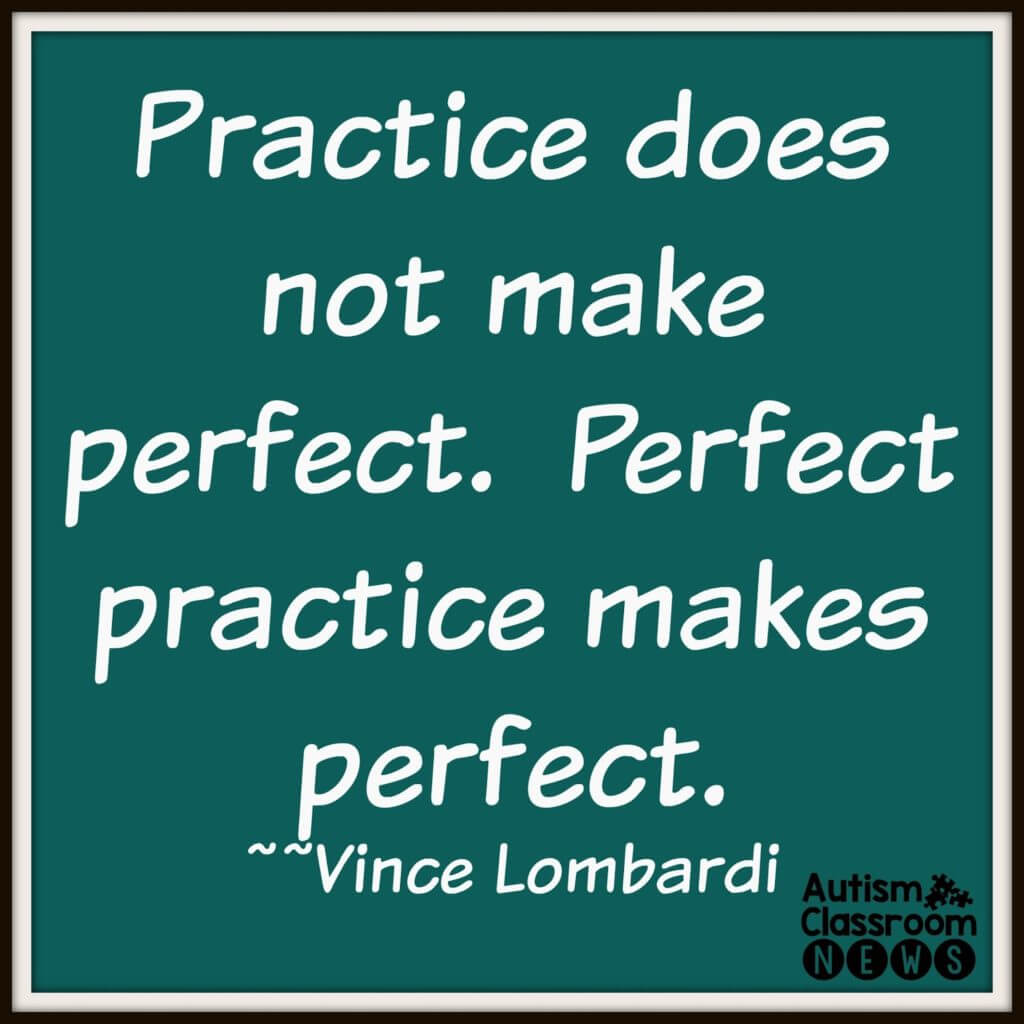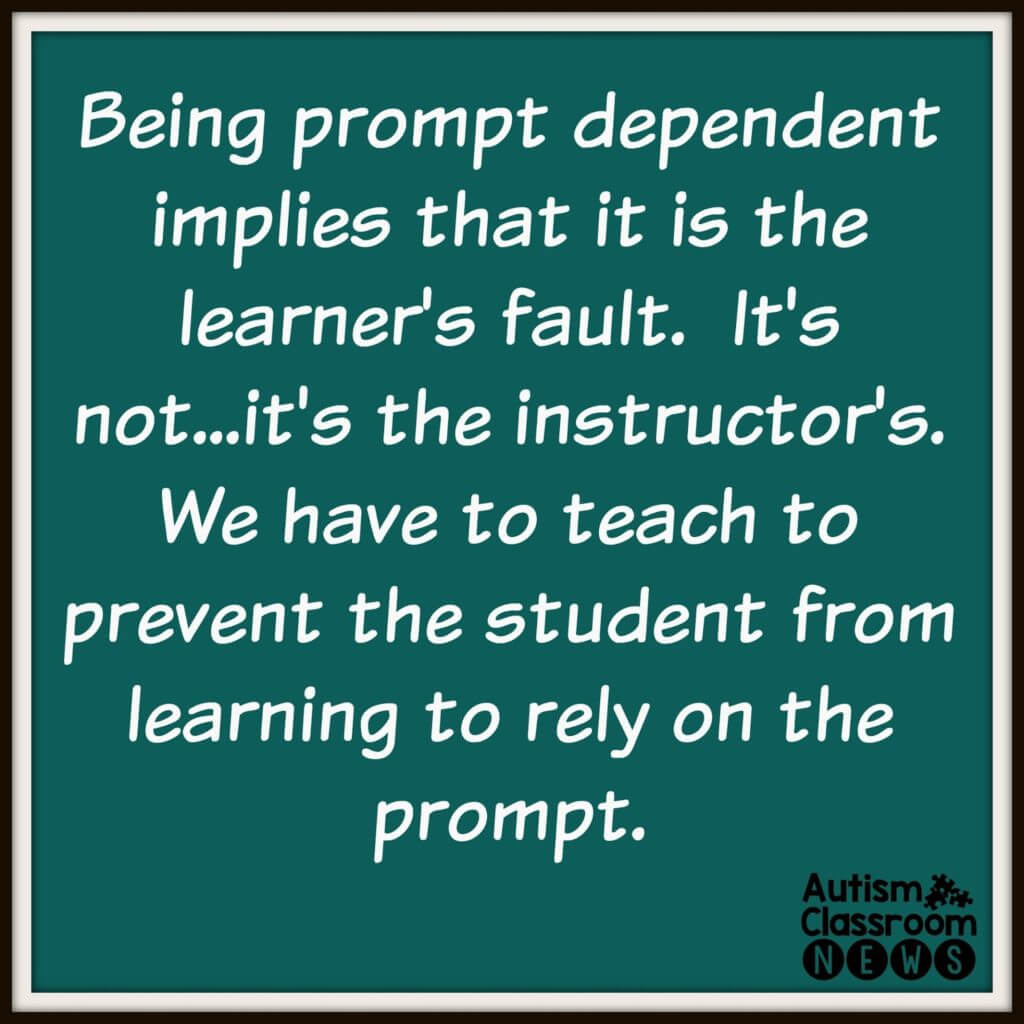 So once our materials and directions in order, we need the learner to provide the correct answer so he comes into contact with the consequence for right answers–a reinforcer (more on that later). A prompt is some type of assistance that we provide to help them get the answer right. It is anything we do after giving the materials and instructions that helps the student give us the right answer or complete the task.
So once our materials and directions in order, we need the learner to provide the correct answer so he comes into contact with the consequence for right answers–a reinforcer (more on that later). A prompt is some type of assistance that we provide to help them get the answer right. It is anything we do after giving the materials and instructions that helps the student give us the right answer or complete the task.
But, many of you probably work with students who, when told to go wash their hands, stand in the bathroom and wait for someone to tell them what to do next (turn on the water). That’s prompt dependence. Students with autism are very susceptible to it, precisely because of reasons I’ve talked about in terms of what details they notice in the learning process (i.e., overselectivity). So as I was riding my bike, I began to think about how prompts are like training wheels. Let me show you how.
1. They Both Build Success
Training wheels are used on a bike to help a learner be successful in riding their bike, allowing them to learn how. Without training wheels, many of us may have had an adult who ran beside our bike holding on to the seat. Most of us did not learn to ride a bike by getting on and trying it without some type of assistance. We didn’t know how to ride it. Had we just gotten on it and tried to ride, chances are good we would fall down immediately or after a few pedals. The same is true with discrete trials. Success is what teaches us. I love to bike. If I fell over every time I rode my bike, I probably wouldn’t do it as much. More than that, if I fell over and didn’t know why, I probably wouldn’t get any better. Prompts allow a learner to come into contact with the consequence of doing the task correctly. For learners, that’s a reinforcer. For a biker, it’s the feeling you get while riding your bike and the sense of satisfaction of learning.
2. They Both Provide Perfect Practice
I recently heard Linda LeBlanc say this but have heard it before (because as a kind reader pointed out, Vince Lombardi said it–Thanks Natalie!). “Practice doesn’t make perfect. Perfect practice makes perfect.” If I practice something enough, I might learn to do it. But if I practice it wrong, I learn to do it wrong. If I practice it the right way each time, I get better at it and learn to do it the right way. Training wheels and prompts both allow me to practice the right way, but the instruction needs to be designed to take advantage of them.
3. We Don’t Want to Use Them Forever
As kids get better on the bike, we want them to lose the training wheels. We want them to ride independently. Most adult-sized bikes don’t have training wheels made for them. Similarly, I love to ride my bike, but I don’t want someone to have to run behind me and hold on to make sure I don’t fall over. Similarly, we want our students to be independent. That means we need to fade the prompts.
4. Some Learners are Resistant to Losing Them
Some kids get rid of the training wheels on their own. Some kids have a hard time when their parents want them to ride on their own. They are scared and might freeze and wait for that push. Sometimes they fall without the training wheels. If we let them ride with training wheels too long, that falling becomes more frightening and they become dependent on them. The same with prompts. Some students move toward independence on their own. Some become very dependent on prompts. They notice the wrong details and we have to program our instruction to prevent that. We also have to be very careful with both using and fading our prompts. We should never help a student with a prompt of any kind without a plan for how we are going to get the prompt out of there.
We tend to think of the student as being “prompt dependent” which makes it the student’s problem. But really, when students become prompt dependent it’s because we didn’t effectively fade out the prompt. Think about it–you wouldn’t see a kid with training wheels long after he started riding and think to yourself, “What is that kid thinking! He needs to lose those training wheels!” No, you would think–don’t that kid’s parents know he’s ready to lose those training wheels? (Clearly this would be something you might think but wouldn’t say). It’s our responsibility as the instructor to figure out how to prevent the student from focusing on the wrong thing and learning the prompt as part of the teaching process.
5. We Tend to Forget About Them
This is one of the biggest issues with prompting. It’s easy to put training wheels on a bike and then forget they are there. The same is true with prompting. I never cease to be amazed when I tell someone (teacher, parent, behavior analyst…really anyone!) don’t prompt, and then they give a gesture, or the first consonant sound of the answer, or even a physical prompt. We are in a helping profession and we want to help so much that sometimes we forget the importance of letting the student do it on his/her own. We even forget (or don’t realize) that we are prompting them….until they can’t do something we thought they could do. This is an issue we will come back to because we need to remove training wheels and prompts…but if we forget we are using them, we aren’t making that effort.
6. They Can Be Faded
One of the appealing things about training wheels is that you can raise them. Raising them effectively fades them for the learner a little at a time. It leaves them there in case you need them, but they aren’t used as often. Prompts can also be faded out through a variety of ways from changing what the stimuli look like and where you put them (we’ll talk about pros and cons of those strategies in a future post) to waiting longer to present them or changing what the prompt is like (e.g., moving from hand-over-hand or physical prompts to gestural prompts to visual prompts). Again, as the instructor it is our responsibility to provide this fading and figure out the best way to fade them out.
So, that will be the focus of my next set of posts–determining what type of prompts to use and how we should structure instruction to fade them out. We will talk about errorless teaching or near-errorless teaching as well as time delay and prompt hierarchies. Plus I’ll talk more about how we decide what types of prompts we should choose to use in our discrete trial instruction.







![Summer resources to help survive the end of the year in special education [picture-interactive books with summer themes]](https://autismclassroomresources.com/wp-content/uploads/2018/05/SUMMER-RESOURCES-ROUNDUP-FEATURE-8528-768x768.jpg)
